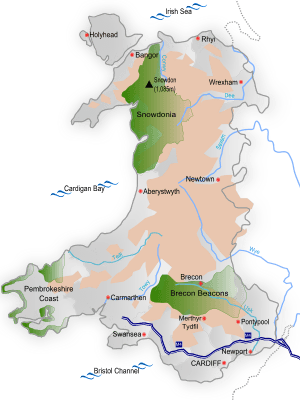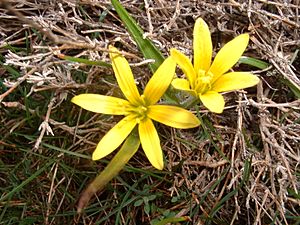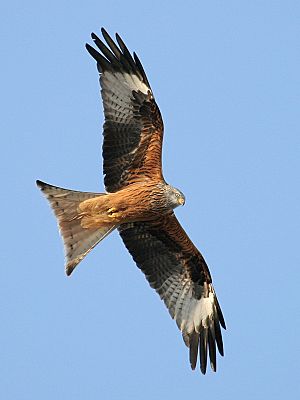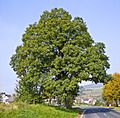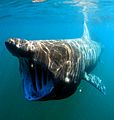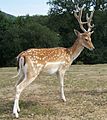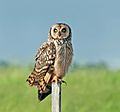Biodiversity of Wales facts for kids
The biodiversity of Wales is all about the amazing variety of living things found in Wales. This includes different types of ecosystems (like forests or coasts), all the different animals and plants, and even the unique genetic information that makes each one special.
Wales is a mostly mountainous peninsula (land surrounded by water on three sides) located between England and the Irish Sea. It covers about 8,023 square miles (20,780 square kilometers). Wales has many natural areas rich in biodiversity. These include three national parks and five Areas of Outstanding Natural Beauty (AONBs).
The national parks are: Snowdonia, Pembrokeshire Coast, and Brecon Beacons. The AONBs include: Anglesey, Clwydian Range, Gower Peninsula, Llŷn Peninsula, and the Wye Valley (which is partly in England). Wales also has many special places like Site of Special Scientific Interests, Special Area of Conservations, and Special Protection Areas. You can also find zoos and gardens, like the National Botanic Garden of Wales.
Along the coast of Wales, you can find many different sea creatures. These include seals, dolphins, sharks, jellyfish, crabs, and lobsters. There are also large groups of seabirds living on islands near the coast. Some species are found only in Wales, like the Radnor lily, the spotted rock-rose, and a fish called the gwyniad. The gwyniad fish lives only in Lake Bala.
The rare fen orchid (Liparis loeselii) is one of the most endangered plants in northwestern Europe. It has disappeared from many places in Wales. The Welsh Government and groups like Natural Resources Wales (NRW) are working to protect it. They help rebuild its natural home to make sure this threatened species survives.
The Welsh government works with the Wales Biodiversity Partnership (WBP). This group helps to plan and check on efforts to protect biodiversity in Wales. In 2010, the Welsh government started a plan called "A Living Wales." This plan focuses on managing land and sea resources in a way that can last for a long time. The Environment (Wales) Act 2016 also helps manage Wales' natural resources in a more sustainable way.
Contents
Amazing Plants of Wales
Wales is home to a wide variety of plants, from tall trees to tiny flowers. These plants form the base of many ecosystems.
Trees in Wales
The sessile oak (Quercus petraea) is one of the most common trees in Wales. You can find it all over the region. English holly (Ilex aquifolium) is one of the few native evergreen trees. It grows mostly in southern Wales. The wych elm (Ulmus glabra) is another native tree. However, it faces challenges from diseases and competition from non-native trees.
Beautiful Flowers of Wales
The cuckoo flower (Cardamine pratensis) is a common plant found throughout Wales. It grows back every year. Bog rosemary (Andromeda polifolia) is a small flowering shrub found in central Wales. The Snowdon lily (Gagea serotina) is very special. Within the whole of the British Isles, it is found only on the slopes of Snowdon mountain.
Important Plant Areas
Plantlife has identified "Important Plant Areas" (IPAs) in Wales. These are places that are super important for plants. They have the highest number of rare or special plant species.
| County / Historic County | Special Plant Species | Where it Grows |
|---|---|---|
| Anglesey / Sir Fon | Spotted rock-rose (Tuberaria guttata) | Dry, rocky places |
| Brecknockshire / Sir Frycheiniog | Cuckooflower (Cardamine pratensis) | Wet grasslands and pond edges |
| Caernarvonshire / Sir Gaernarfon | Snowdon lily (Gagea serotina) | Mountain rocks |
| Cardiff / Caerdydd | Wild leek (Allium ampeloprasum) | Sandy and rocky places near the sea |
| Cardiganshire / Ceredigion | Bog-rosemary (Andromeda polifolia) | Mid-Wales |
| Carmarthenshire / Sir Gaerfyddin | Whorled caraway (Carum verticillatum) | Damp meadows |
| Denbighshire / Sir Ddinbych | Limestone woundwort (Stachys alpina) | Roadsides and hedges |
| Flintshire / Sir Fflint | Bell heather (Erica cinerea) | Heaths and moors |
| Glamorgan / Morgannwg | Yellow whitlow-grass (Draba aizoides) | Rocks and old walls |
| Merioneth / Merionnydd | Welsh poppy (Meconopsis cambrica) | Damp, shady rocks |
| Monmouthshire / Sir Fynwy | Foxglove (Digitalis purpurea) | Woodland clearings, heaths and banks |
| Montgomeryshire / Sir Drefaldwyn | Spiked speedwell (Veronica spicata) | Limestone rocks |
| Pembrokeshire / Sir Benfro | Thrift (Armeria maritima) | Coastal cliffs or on rocky islands |
| Radnorshire / Sir Faesyfed | Radnor lily (Gagea bohemica) | Limestone rocks |
Amazing Animals of Wales
Wales is home to many different kinds of animals, from large mammals to tiny insects.
Marine Life
Around Cardigan Bay and the Pembrokeshire coast, you can often spot minke and pilot whales in the summer. Bottlenose dolphins are also common. Sometimes, you might even see fin and killer whales, though they are rare. Other amazing sea creatures include grey seals, huge basking sharks, and sunfish.
Mammals on Land
The two largest mammal species in Wales are Roe deer (Capreolus capreolus) and fallow deer (Dama dama). Roe deer live in central and northern Wales. Fallow deer can be found in both country and town areas. The European polecat (Mustela putorius) lives in both cities and the countryside. The red fox is also very common in Wales.
The red deer is the biggest non-marine mammal in Wales. It is one of five native deer species. You can also find fallow, muntjac, roe, and sika deer. pine martens are very rarely seen. Other mammals include badgers, hares, hedgehogs, otters, rabbits, stoats, weasels, red squirrels, and 13 different kinds of bats.
Birds in the Sky
About 420 different kinds of birds have been seen in Wales. Red kites and ospreys are like "signature species" for Wales. You can also commonly see Dippers, choughs, puffins, guillemots, razorbills, short-eared owls, Manx shearwaters, whimbrel, and plovers.
Montagu's harrier (Circus pygargus) is a rare bird in Britain, but it has several nesting spots in Wales. The Red grouse (Lagopus lagopus scotica) used to be common, but its numbers have dropped a lot because of hunting. You can find red grouse in the far north of Wales. The King eider (Somateria spectabilis) is also hunted for its feathers.
Reptiles on the Ground
Wales has several types of reptiles. These include adders, common lizards, and grass snakes. Some sand lizards, which were raised by volunteers and zoos, have been released back into the wild to help their numbers grow.
Priority Species for Conservation
Many species in Wales are considered "priority species." This means they need special attention and protection to make sure they survive.
| Priority Species | Priority Species |
|---|---|
| Lesser horseshoe bat (Rhinolophus hipposideros) | Greater horseshoe bat (Rhinolophus ferrumequinum) |
| Common pipistrelle (Pipistrellus pipistrellus) | Common dolphin (Delphinus delphis) |
| Natterjack toad (Bufo calamita) | Grass snake (Natrix natrix) |
| Common lizard (Lacerta vivipara) | Pine marten (Martes martes) |
| Chough (Pyrrhocorax pyrrhocorax) | Common toad (Bufo bufo) |
| Harbour porpoise (Phocoena phocoena) | Bottlenose dolphin (Tursiops truncatus) |
| Minke whale (Balaenoptera acutorostrata) | Otter (Lutra lutra) |
| Marsh fritillary (Euphydryas aurinia) | Twait shad (Alosa fallax) |
| Great crested newt (Triturus cristata) | Adder (Vipera berus) |
| Skylark (Alauda arvensis) | Polecat (Mustela putorius) |
| Water vole (Arvicola terrestris) | Risso's dolphin (Grampus griseus) |
Unique Species of Wales
Some species are native to Wales, meaning they naturally belong there. Protecting these native species is very important for the local environment.
Native Trees
Native trees in Wales include ash, birch, oak, willow, holly, juniper, Scots pine, and yew. It's a good idea to plant and protect these native trees. They are better at surviving in the local climate and help keep the environment balanced. They also provide wood.
Native Flowering Plants
Some native flowering plants include ash, service tree, wild leeks, and the Tenby daffodil.
Mosses and Liverworts
Wales has over 300 different kinds of mosses and liverworts. Some of these are endangered, like Bartramia stricta and Petalophyllum ralfsii.
Native Mammals
- Lesser horseshoe bat (Rhinolophus hipposideros)
- Red squirrels
Native Birds
- Hen harrier
- Black grouse
- Curlew
- Golden plover
Native Reptiles
There are five native reptiles in Wales. These include grass snakes, sand lizards, common lizards, and slowworms.
Native Amphibians
Wales has six native amphibians. They are the common toad, great crested newt, natterjack toad, palmate newt, smooth newt, and common frog.
Invertebrates
It's estimated that about 25,000 different kinds of invertebrates (animals without backbones, like insects and spiders) live in the land and freshwater habitats of Wales.
How Humans Affect Biodiversity
Human activities have sometimes caused a reduction in Wales' biodiversity. For example, many native species have struggled because there isn't enough woodland to support them.
Impact on Animals
Many projects are working to protect the red squirrel. Sadly, the number of hedgehogs has greatly declined. The use of pesticides has also caused a big drop in honeybee numbers. To help, a Pollinator Action plan was started in July 2012.
Protecting Wales' Nature
Wales has a list of 175 "Species of Principal Importance for the Conservation of Biological Diversity." This list helps guide conservation efforts. The United Kingdom Biodiversity Action Plan (UKBAP) is put into action in Wales by the Wales Biodiversity Partnership (WBP). The Countryside Council for Wales also helps with managing nature in a sustainable way.
The Wales Biodiversity Partnership (WBP) plans the overall conservation work. Locally, each council does its own surveys and reports. Then, they create plans to manage and protect the special species and habitats they find. The Welsh government also works with European rules to protect wild birds, natural habitats, and wild plants and animals.
Images for kids


